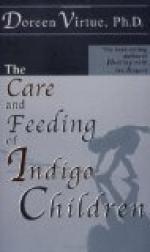What general rule can be given for increasing the food?
To increase when the infant is not satisfied but is digesting well.
How does an infant show that he is not satisfied?
He drains the bottle eagerly and cries when it is taken away. He often forms the habit of sucking his fingers immediately after. He begins to fret half an hour or an hour before the next feeding is due.
In the series of formulas given in the table the quantities are mentioned for making only twenty ounces of food. How should it be prepared when more than this quantity is needed?
It is equally convenient to make up 25 ounces, 30 ounces, 35 ounces, or 40 ounces at a time.
To make—
25 ounces of any formula add one quarter more of each ingredient. 30 " " one half " " 35 " " three quarters " " 40 " " twice as much " "
Thus 25 ounces of Formula I would be obtained by using 21/2 ounces of milk, 11/4 ounces of sugar and lime-water, 211/4 ounces of water; 30 ounces of the same would require 3 ounces milk, 11/2 ounces lime-water and sugar, and 251/2 ounces water; 35 ounces would require 31/2 ounces milk, 13/4 ounces lime-water and sugar, and 293/4 ounces water. The amount of water need not be calculated in any case, but after measuring carefully the other ingredients enough water should be added to bring the total up to the amount required.
How great an increase in the quantity should be made at one time?
One may make up five ounces additional food; but the first two days only two or three ounces of the additional amount should be given; the next two days, four ounces; after two days more, the five ounces may be given.
The increase in the quantity given at a single feeding should not be more than a quarter of an ounce.
FOOD FOR HEALTHY INFANTS—THE LATER MONTHS
How long should the fat be as much as three times the proteids?
This is seldom of advantage longer than three or four months.
What changes should then be made in the milk?
After Formula V of the First Series (6 ounces of 10-per-cent milk in 20 ounces of food) has been reached, the fat should be increased very slowly for this proportion (3 per cent) is near the limit for most healthy children. The milk should now be strengthened chiefly by raising the percentage of proteids.
How is this accomplished?
The 10-per-cent milk and the formulas derived from it should now be discontinued, and those made from 7-per-cent milk used.
Third Series
Formulas for the Later Months from 7-per-cent Milk




